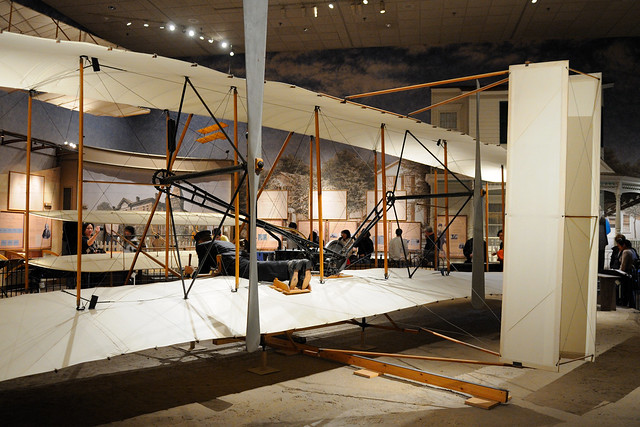
Wright Flyer 1903
The Wright brothers inaugurated the aerial age with the world's first successful flights of a powered heavier-than-air flying machine. The Wright Flyer was the product of a sophisticated four-year program of research and development conducted by Wilbur and Orville Wright beginning in 1899. After building and testing three full-sized gliders, the Wrights' first powered airplane flew at Kitty Hawk, North Carolina, on December 17, 1903, making a 12-second flight, traveling 36 m (120 ft), with Orville piloting. The best flight of the day, with Wilbur at the controls, covered 255.6 m (852 ft) in 59 seconds.
The Wrights pioneered many of the basic tenets and techniques of modern aeronautical engineering, such as the use of a wind tunnel and flight testing as design tools. Their seminal accomplishment encompassed not only the breakthrough first flight of an airplane, but also the equally important achievement of establishing the foundation of aeronautical engineering.
The Flyer received some minor repairs and cleaning in 1976 just before being moved into the Smithsonian's then new National Air and Space Museum building. In 1985, the airplane was given its first major treatment since preparing it for loan to the Science Museum in late 1926 and early 1927. It was completely disassembled, the parts thoroughly cleaned and preserved, and all new fabric covering applied. A careful search was made to locate new fabric that matched the original as closely as possible. When the fabric was replaced in 1927, it was sewn on in a slightly different way than originally done by the brothers in 1903. When stitching the new fabric in 1985, a large section of original flown 1903 wing covering was available and used as a pattern, ensuring the accuracy of the 1985 restoration.
Tags
Washington
Smithsonian
Institution
NASM
National
Air and Space
Museum
Mall
Wright
Flyer
1903
kitty hawk north carolina, wilbur and orville wright, wilbur and orville, hawk north carolina, december 17 1903, national air and space museum, orville wright, air and space museum, careful search, wright flyer, aeronautical engineering, heavier than air, science museum, wright brothers, wind tunnel, first flight, air and space, gliders, design tools, tenets
No comments:
Post a Comment